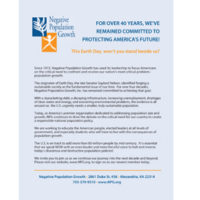New NPG Paper Sees State of the Union As Touting Further Population Growth
- NPG
- February 11, 2015
- Press Releases
- 0 Comments
New NPG Paper Sees State of the Union As Touting Further Population Growth
Analysis of recent State of the Union address finds it “missed a real opportunity” to educate and mobilize the American public on major troublesome trends.
View this release on PRWeb
This press release was picked up by 262 news outlets across the country, including: The Miami Herald, The Boston Globe, Star Tribune, and local affiliates for all major television networks. Together, NPG’s message was distributed to a prospective audience of nearly 227 million Americans.
Click here for a downloadable, printable PDF version
Alexandria, VA (February 3, 2015) – In response to President Obama’s January 20th State of the Union address, Negative Population Growth (NPG) will release a new Forum paper on February 5th. Senior NPG Advisor David Simcox, who authored the upcoming paper, asserts: “not surprisingly, the pursuit of economic growth was the holy grail” of the speech. The paper highlights the costs of such growth, identifying a number of the President’s boasted plans and achievements as “setbacks on the road to a sustainable future.”
Titled State of the Union Address: Touting More Growth with More People, the NPG Forum paper counters many of the President’s proposals to further expand America’s immigration numbers – and those that would increase U.S. population. Simcox notes: “The President foresaw rich economic returns” in his plan, which would “grant permanent legal status and ultimately green cards to some 11 million unlawful residents, while doubling the annual intake of new legal immigrants.” However, Simcox warns: “There has been virtually no expression of concern during the debate in the Senate, in the Executive branch, or in the President’s speech over this prospective surge of imported population growth and its subsequent demographic echoes.”
Citing a 2012 Census Bureau report, Simcox notes: “Unexplained here is how vast expansion of America’s intake of disadvantaged populations will increase per capita incomes, create more full-time and high-quality jobs, or suddenly change the present revenue deficit to a surplus.” Confronting the President’s push for jobs, the NPG Forum paper asks a critical question: “If the need for job creation and relief to the unemployed is so critical, shouldn’t Washington first consider immigration reduction and greater selectivity instead of further expansion?” Simcox’s report also counters the President’s call for improvements to U.S. infrastructure. He notes: “Continuous U.S. population growth now is outrunning our political will – and financial means – to keep up with the country’s infrastructure needs.”
Simcox adds: “Ours is a huge and complex government: White House speech writers have to pick and choose from myriad issues for optimal political impact. There is a tendency to avoid intractable problems –
or those that might require serious sacrifice or jarring lifestyle changes. Even so, the President’s ghost writers missed a real opportunity to educate and mobilize the public on some major troublesome trends and events – all of which stem from population growth, or are aggravated by it.” Explaining how population growth is at the root of many of America’s greatest problems, Simcox goes on to suggest some of the issues that should be addressed in future States of the Union: affordable housing, drought and water shortages, and the loss of open space and farmland.
The paper concludes: “What is needed is a State of the Union message devoted to rising population and environment ills. The President giving this much-needed report should create a national population commission – with the goal of setting a national policy of population limits, and measures to make them work against the likely storm of myriad pro-populationist interests. If researchers are correct in their projections for U.S. population growth and resource depletion, the resulting crowding and environmental decay may soon make such a modern-day paradigm shift seem more necessary – and appealing – to the American public and policymakers.”
This NPG national Press Release was picked up by hundreds of media outlets across America, reaching a potential audience of nearly 200,000,000 people.

